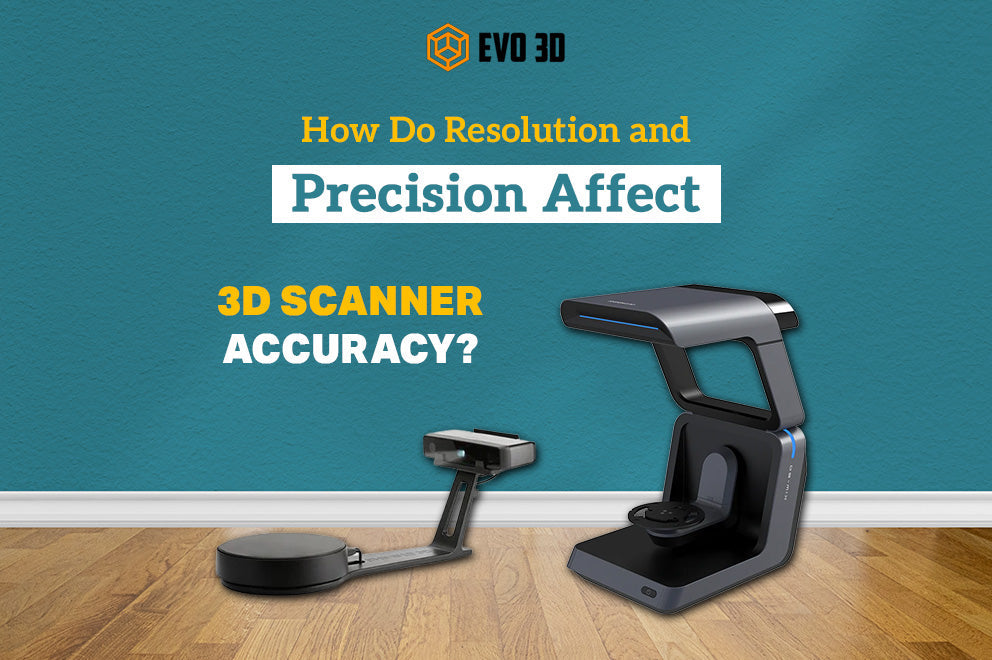How Do Resolution and Precision Affect 3D Scanner Accuracy?

Accuracy refers to how close a measurement is to its actual value. In 3D scanning, even small errors can cause major problems—especially in industries like engineering, healthcare, and manufacturing.
That’s why it’s important to understand terms like resolution and precision. These aren't just technical words. They play a big role in how good your scan results are.
Think of accuracy as the truth. Precision is about getting the same result again and again, whereas resolution is the amount of detail your 3D scanner can capture. If some scans look clearer or more reliable than others, these factors are likely the reason.
Whether you are scanning a product prototype or a piece of ancient art, the right balance of resolution and precision will affect your results. Picking the right 3D scanner means knowing how these features work together.
Big brands like HP, Artec, and FARO design their scanners to offer the best mix of detail and consistency. At Evo 3D, we know how important accuracy is. That’s why our solutions are built to meet the unique needs of your projects, no matter the size or industry.
Understanding Resolution and Precision in a 3D Scanner
When you are choosing a 3D scanner, two of the most important specifications you will see are resolution and precision. These terms are often used interchangeably, but they mean different things, and both play an important role in how accurate your scans will be.
Resolution refers to the level of detail a 3D scanner can capture. It’s measured in terms like point spacing or pixel size. The higher the resolution, the more detail your scanner can pick up, especially on complex structures or small objects.
For example, high-resolution scanners are ideal for tasks like dental scanning, jewellery design, or capturing fine textures in art restoration.
Precision means how consistent your scan results are when you scan the same object multiple times. A highly precise scanner will give you nearly identical results every time, even if the scan is repeated under the same conditions. It is especially important in quality control and other industrial applications where repeatability matters more than ultra-fine detail.
Why Do Precision and Resolution Matter For 3D Scanner Accuracy?
Have you ever scanned something, only to find the result didn’t match the real thing? That’s where precision and resolution come in. These two factors decide how much detail your industrial 3D scanner captures and how consistent your results are.
Without them, even the best-looking scan might be inaccurate. Whether you are designing a prototype, inspecting a part, or preserving a museum artefact, you need data you can trust. That’s why understanding these specifications isn't just technical, it’s important to getting correct results. Want to know how resolution and precision affect 3D scanner accuracy? Continue reading below:
Resolution determines the level of surface detail captured
How much detail can a 3D scanner capture? When working on complex designs or scanning small or complex objects, this is where resolution plays an important role. It determines the ability of a 3D scanner to capture fine surface textures, sharp edges, or subtle details, things that a human eye can miss.
Whether you are scanning for jewellery design, dental applications, or heritage restoration, a high-resolution 3D scanner ensures that every feature is recorded accurately. If you are using a low-resolution scanner, those details may blur or disappear entirely, affecting the quality of your 3D model. For professionals using large format 3D printers and scanners, they can ensure better print results. That’s why resolution isn’t just a technical detail; it’s a core part of achieving accuracy.
Precision reflects consistency across multiple scans
In the world of 3D, precision is a factor which builds trust. It refers to how consistently an industrial 3D scanner can reproduce the same measurements when scanning the same object multiple times. Even if the scan looks good once, a lack of precision can lead to inconsistencies in future scans, which is a big problem in industries like quality control or product inspection.
For those working with both 3D scanners and large-format 3D printers, consistent scan data ensures your models align perfectly from concept to production. A precise 3D scanner saves time, reduces error, and helps build impeccable 3D models every single time.
Accuracy comes from the right balance of both
Is your 3D scanner delivering both detail and consistency? Accuracy doesn’t rely on just one factor; it’s the result of a well-balanced combination of resolution and precision. You could have a high-resolution scanner that can capture every scratch or texture, but if it can’t deliver the same results across multiple scans, it's not truly reliable.
On the other hand, a high-quality scanner with poor resolution may not miss critical surface detail. That’s why professionals across industries, from engineering to healthcare, choose 3D scanners that offer both. When resolution and precision are aligned, you get accurate scans that translate seamlessly into real-world applications.
Explore High-Precision 3D Scanners Built for Accuracy.
In 3D scanning, accuracy is everything. Whether you are capturing the intricate details of a historic artefact or ensuring precise measurements for manufacturing, both resolution and precision are key to reliable results. A high-resolution 3D scanner captures the finest details, while high precision guarantees consistent outcomes every time you scan.
Leading brands like HP design their scanners with these critical factors in mind, offering solutions tailored to a wide range of industries—from healthcare and engineering to art restoration and quality control.
At Evo3D, we are proud to deliver high-precision scanners built to meet your specific project requirements, no matter the scale or complexity.
Looking for a 3D scanner that balances detail and consistency? Explore our expert recommendations or contact us today to find the perfect 3D scanning solution for your needs.
